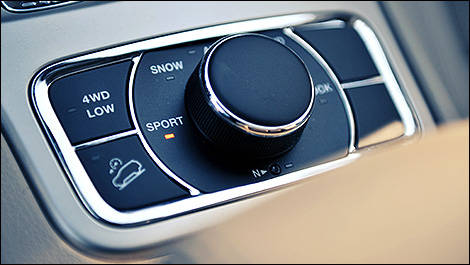A slew of advanced, electronic driver aids once reserved for the market's most cutting-edge models are now available for virtually any Canadian shopper in the new-car market.
Advanced braking system technology, traction and stability controls, and All Wheel Drive (AWD) or Four Wheel Drive (4WD) are now more mainstream than ever before -- and if you're re-entering the marketplace for the first time in several years, you'll be delighted with the changes.
At their core, features like these go a long way to enhance performance, safety and confidence by maximizing the use of available traction at the road's surface. That's especially important for winter driving when snow, ice and cold temperatures reduce your grip on the road.
Here's a look at some of the latest stability-enhancing features you'll likely find available on your next ride -- and how they work to make winter driving a less stressful experience.
Electronic Stability Control (ESC)
This system is marketed by automakers under different names, which include "StabiliTrak," "Vehicle Dynamics Management" (VDM) and "Vehicle Stability Assist" (VSA). Regardless of the name, an ESC system works to help keep vehicles out of dangerous skids -- and industry authorities are recognizing it as a life-saving technology.
By monitoring vehicle behaviour and comparing it with driver intentions via the steering, ESC can instantaneously recognize conditions that will lead to a skid or fishtail. When these conditions are detected, the system instantaneously reduces engine power and applies split-second brake pulsations to specific wheels. This happens with no driver involvement, and often before the driver realizes a skid was about to occur.
A key to the system's effectiveness is that it reacts far more quickly, precisely and consistently than a human being ever could. The benefits of ESC are even more pronounced in wintertime, when skidding and sliding is more likely. Used with proper winter tires, ESC is arguably the single most important weapon in the fight against wintertime skids.
Traction Control
On an icy or snow-covered road, a spinning set of wheels will get you nowhere fast. In fact, excessive wheelspin can slow down your acceleration and result in a loss of control, too. Traction Control detects that excessive wheelspin, which is typically encountered on slippery surfaces, and reacts by ramping down engine power and momentarily "touching" the brakes on the drive wheels to reduce their slipping. Result? Acceleration is maximized on any surface any time you take off. That's a good thing if you're trying to quickly get moving.
Advanced Antilock Brakes
The Antilock Braking System (ABS) has been around for a while, but in the recent past a slew of enhancements to ABS functionality have been adopted by automakers everywhere.
Braking technology has been evolving steadily, and today's braking systems commonly deliver both Electronic Brake Distribution (EBD) and Brake Assist (BA).
Electronic Brake Distribution (EBD) works to mete out stopping power on a wheel-by-wheel basis, effectively applying a "just-right" amount of stopping power to each wheel and compensating for varying surface traction or an unevenly loaded ride. The result (to the driver) is that stops occur in a straight line, and with stability and predictability.
You're likely to notice the effects of EBD in a panic-stop situation when you're crossover or minivan is filled with people and gear -- and especially when the tires are on two different surfaces with varying amounts of traction.
Brake Assist (BA) automatically boosts stopping power if a panic-stop situation is detected, compensating for a tendency drivers have of not applying enough initial brake pressure in emergency situations. When the brakes are applied suddenly, as is typical in an emergency, BA kicks in to help get the vehicle to a standstill faster by effectively making the brake pedal more sensitive. On a snowy road, this system can make the difference between stopping ahead of an accident, or winding up in one.
Trailer Sway Control
A swaying trailer, especially in wintertime, can be a dangerous and startling condition for drivers and their families. Trailer Sway Control is an enhanced functionality programmed into the Electronic Stability Control (ESC) system on many new crossovers and pickup trucks. In a nutshell, it employs sensors that measure the "yaw" created by unexpected side-to-side motions of a trailer caused by crosswinds or road conditions.
When trailer sway is detected, the system automatically, instantly and consistently corrects the unwanted motions by applying brakes on the tow vehicle in a way that stabilizes the trailer. Look for this feature if you're planning to haul your snowmachines, ice-fishing hut or ATVs around this wintertime.
All Wheel Drive (AWD) / Four Wheel Drive (4WD)
Today, AWD and 4WD systems are more efficient, affordable and common than ever. Many automakers, including Suzuki, Subaru, and Mitsubishi even offer AWD or 4WD on their compact models. Most systems operate with no driver involvement while automatically boosting traction whenever it's needed. The latest engineering and technology mean today's AWD and 4WD systems operate seamlessly and with negligible effects on fuel economy, too.
Advanced braking system technology, traction and stability controls, and All Wheel Drive (AWD) or Four Wheel Drive (4WD) are now more mainstream than ever before -- and if you're re-entering the marketplace for the first time in several years, you'll be delighted with the changes.
At their core, features like these go a long way to enhance performance, safety and confidence by maximizing the use of available traction at the road's surface. That's especially important for winter driving when snow, ice and cold temperatures reduce your grip on the road.
Here's a look at some of the latest stability-enhancing features you'll likely find available on your next ride -- and how they work to make winter driving a less stressful experience.
 |
| Photo: Matthieu Lambert |
Electronic Stability Control (ESC)
This system is marketed by automakers under different names, which include "StabiliTrak," "Vehicle Dynamics Management" (VDM) and "Vehicle Stability Assist" (VSA). Regardless of the name, an ESC system works to help keep vehicles out of dangerous skids -- and industry authorities are recognizing it as a life-saving technology.
By monitoring vehicle behaviour and comparing it with driver intentions via the steering, ESC can instantaneously recognize conditions that will lead to a skid or fishtail. When these conditions are detected, the system instantaneously reduces engine power and applies split-second brake pulsations to specific wheels. This happens with no driver involvement, and often before the driver realizes a skid was about to occur.
A key to the system's effectiveness is that it reacts far more quickly, precisely and consistently than a human being ever could. The benefits of ESC are even more pronounced in wintertime, when skidding and sliding is more likely. Used with proper winter tires, ESC is arguably the single most important weapon in the fight against wintertime skids.
Traction Control
On an icy or snow-covered road, a spinning set of wheels will get you nowhere fast. In fact, excessive wheelspin can slow down your acceleration and result in a loss of control, too. Traction Control detects that excessive wheelspin, which is typically encountered on slippery surfaces, and reacts by ramping down engine power and momentarily "touching" the brakes on the drive wheels to reduce their slipping. Result? Acceleration is maximized on any surface any time you take off. That's a good thing if you're trying to quickly get moving.
Advanced Antilock Brakes
The Antilock Braking System (ABS) has been around for a while, but in the recent past a slew of enhancements to ABS functionality have been adopted by automakers everywhere.
Braking technology has been evolving steadily, and today's braking systems commonly deliver both Electronic Brake Distribution (EBD) and Brake Assist (BA).
Electronic Brake Distribution (EBD) works to mete out stopping power on a wheel-by-wheel basis, effectively applying a "just-right" amount of stopping power to each wheel and compensating for varying surface traction or an unevenly loaded ride. The result (to the driver) is that stops occur in a straight line, and with stability and predictability.
You're likely to notice the effects of EBD in a panic-stop situation when you're crossover or minivan is filled with people and gear -- and especially when the tires are on two different surfaces with varying amounts of traction.
Brake Assist (BA) automatically boosts stopping power if a panic-stop situation is detected, compensating for a tendency drivers have of not applying enough initial brake pressure in emergency situations. When the brakes are applied suddenly, as is typical in an emergency, BA kicks in to help get the vehicle to a standstill faster by effectively making the brake pedal more sensitive. On a snowy road, this system can make the difference between stopping ahead of an accident, or winding up in one.
Trailer Sway Control
A swaying trailer, especially in wintertime, can be a dangerous and startling condition for drivers and their families. Trailer Sway Control is an enhanced functionality programmed into the Electronic Stability Control (ESC) system on many new crossovers and pickup trucks. In a nutshell, it employs sensors that measure the "yaw" created by unexpected side-to-side motions of a trailer caused by crosswinds or road conditions.
When trailer sway is detected, the system automatically, instantly and consistently corrects the unwanted motions by applying brakes on the tow vehicle in a way that stabilizes the trailer. Look for this feature if you're planning to haul your snowmachines, ice-fishing hut or ATVs around this wintertime.
All Wheel Drive (AWD) / Four Wheel Drive (4WD)
Today, AWD and 4WD systems are more efficient, affordable and common than ever. Many automakers, including Suzuki, Subaru, and Mitsubishi even offer AWD or 4WD on their compact models. Most systems operate with no driver involvement while automatically boosting traction whenever it's needed. The latest engineering and technology mean today's AWD and 4WD systems operate seamlessly and with negligible effects on fuel economy, too.


